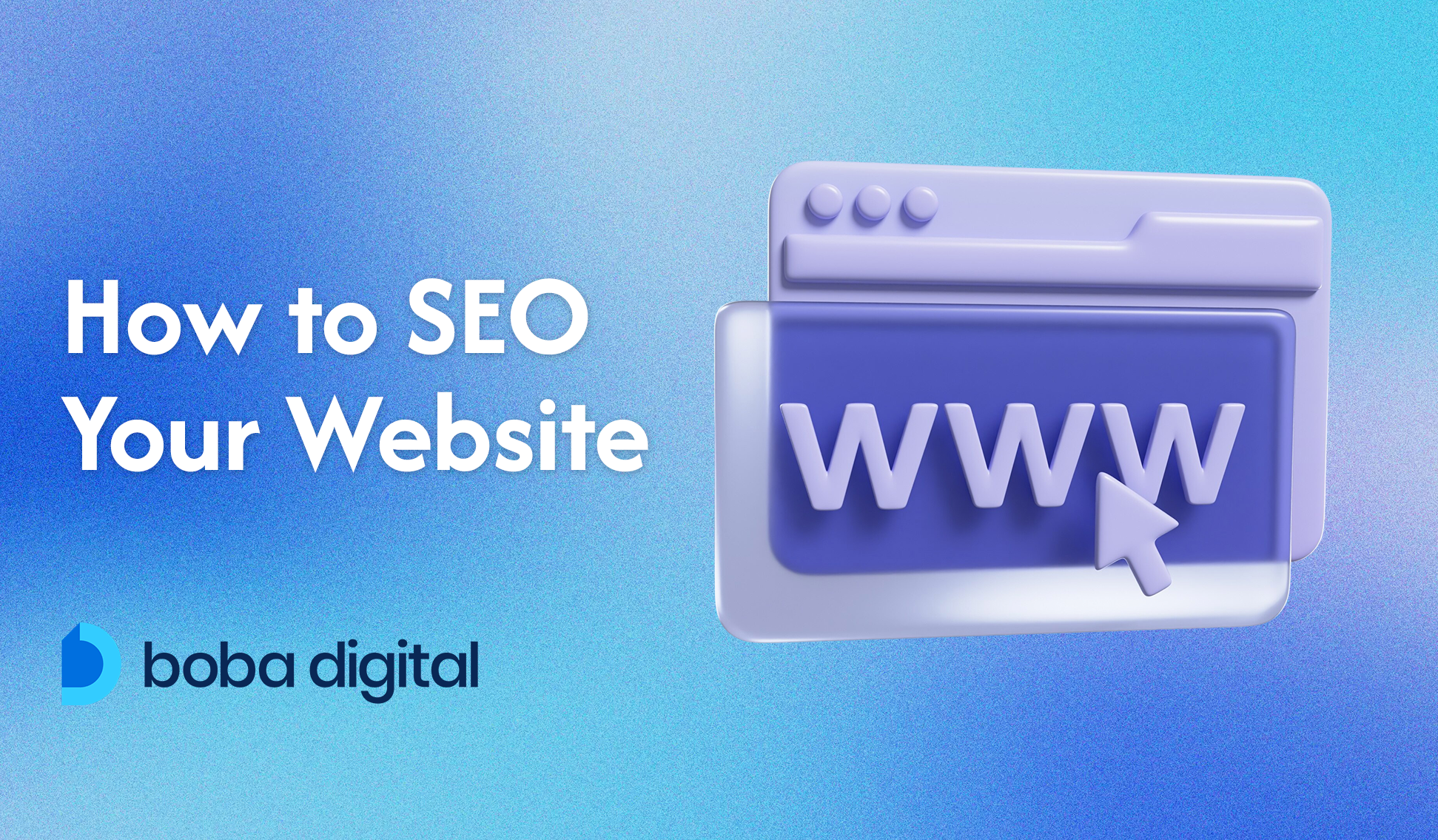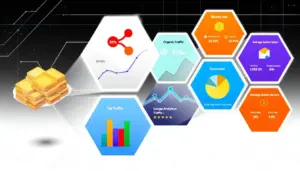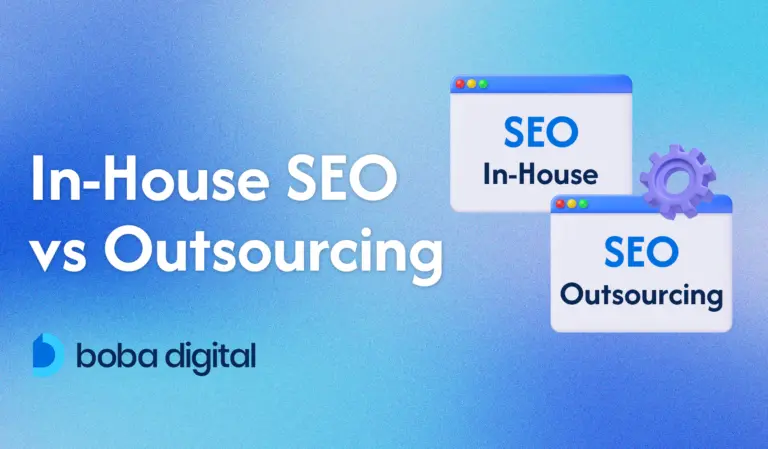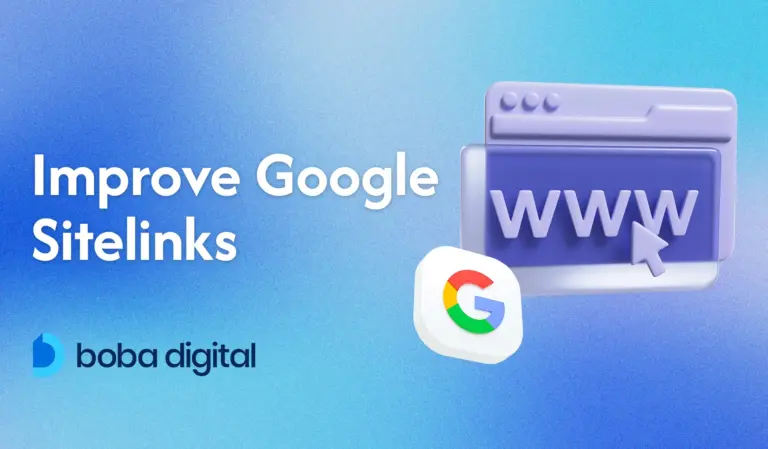How to SEO your Website for Better Rankings & Traffic
Looking to improve your website’s visibility and attract more visitors? This guide on how to SEO your website will cover the key steps: setting up your site, keyword research, on-page optimization, off-page SEO, and technical SEO.
Key Takeaways
- Establishing a solid SEO foundation involves selecting a suitable platform, securing a memorable domain name, and ensuring mobile responsiveness to enhance user experience and search visibility.
- Conducting thorough keyword research is vital for aligning content with user intent, focusing on long-tail keywords to boost engagement and conversion rates.
- Optimizing on-page elements like title tags, meta descriptions, and headings, along with creating high-quality content that adheres to E-E-A-T principles, significantly improves search rankings and user trust.
- Emphasizing off-page SEO is crucial, involving activities like building backlinks and promoting the site on various platforms. While off-page tactics can provide immediate results, creating valuable content fosters long-term growth and user engagement.
Understanding Search Engine Optimization (SEO)
Search Engine Optimization (SEO) is the art and science of enhancing a website’s visibility in search engine results pages (SERPs). By understanding how search engines operate and what users are searching for, you can optimize your website’s content and structure to achieve higher rankings. This process involves a blend of strategies and techniques aimed at improving your site’s performance in search results, ultimately driving more organic traffic.
What is SEO and How Does it Work?
SEO is a cost-effective strategy to attract visitors to your website. It encompasses three main types of optimizations: on-page, off-page, and technical. On-page optimization focuses on refining the content and structure of your web pages to make them more appealing to search engines. Off-page optimization involves activities like building backlinks and promoting your site across various platforms to enhance its authority. Technical optimization addresses the backend aspects of your site, such as improving page speed and ensuring mobile-friendliness, to provide a seamless user experience.
How Search Engines Actually Work
Search engines like Google use complex algorithms to discover, index, and rank web pages. Understanding this process is crucial for effective SEO. The journey from a user’s query to the search results involves three key steps: crawling, indexing, and ranking.
Search Engine Crawling and Indexing
Search engines deploy web crawlers, also known as spiders or bots, to scour the internet for new and updated content. These crawlers navigate through web pages, following links to discover new content. Once a page is found, it is indexed, meaning it is stored in a vast database of web pages. This indexed content is what search engines draw from when generating search results.
Search Engine Ranking Factors
Numerous factors influence how search engines rank web pages. Some of the most critical ranking factors include:
- Content Quality and Relevance: High-quality, relevant content that meets user intent is paramount.
- User Experience: A positive user experience, including easy navigation and engaging content, boosts rankings.
- Mobile-Friendliness: With the rise of mobile browsing, having a mobile-friendly site is essential.
- Page Speed: Fast-loading pages improve user satisfaction and search engine rankings.
- Technical SEO: Proper technical setup, including clean code and secure connections, is vital.
- Backlinks: Quality backlinks from reputable sites signal authority and trustworthiness.
- Social Signals: Engagement on social media can indirectly influence SEO.
- Domain History: A well-established domain with a good track record can rank higher.
- Outbound Links: Linking to authoritative sources can enhance your content’s credibility.
- Site Structure: A well-organized site helps search engines understand and index your content better.
- Keywords in URL: Including relevant keywords in your URLs can improve search visibility.
By focusing on these ranking factors, you can optimize your website to perform better in search results, driving more traffic and achieving higher visibility.
Set Up Your Website for SEO Success
The first step toward SEO success involves choosing the right platform, securing a memorable domain name, and making sure your site is mobile responsive. These elements boost search engine optimization and enhance user experience through search engine optimization SEO.
Opt for a platform like WordPress for its flexibility and SEO benefits, supporting your website’s long-term growth. Ensure your domain name is unique, memorable, and concise to resonate with your audience and brand.
With more than half of web traffic coming from mobile devices, a mobile-responsive site is non-negotiable. These foundational steps create a website that search engines love and users enjoy. Here’s a closer look at each step.
Choose a Platform
The right website platform is crucial for SEO success. WordPress is recommended for its flexibility and array of SEO benefits, supporting long-term growth and improving SEO over time.
With WordPress, you can leverage numerous plugins and tools that cater specifically to search engine optimization, ensuring your website remains adaptable and optimized as your SEO strategy evolves.
Secure a Domain Name
A unique and memorable domain name is vital for establishing your online brand. A concise and relevant name enhances user engagement by making it easier for visitors to remember and return. Ensure it’s easy to spell and pronounce, reflecting your brand effectively.
Ensure Mobile Responsiveness
With Google’s mobile-first indexing approach and over half of web traffic coming from mobile devices, providing a seamless mobile experience is crucial. Test your site on various mobile devices to ensure it functions smoothly and meets user needs.
When selecting a theme for your website, prioritize mobile responsiveness and its alignment with your brand identity. A mobile-responsive site not only retains visitors but also improves search engine rankings. By ensuring your site is mobile-friendly, you cater to a significant portion of your audience and enhance your overall SEO performance.
Conduct Comprehensive Keyword Research
Keyword research forms the bedrock of any successful SEO strategy. Understanding customer perspectives helps identify relevant terms, setting the stage for content that resonates with your audience and ranks well in search results.
Utilize powerful keyword research tools to discover and validate keywords. Analyze search intent to ensure your content aligns with what users are looking for, and identify long-tail keywords that can yield better conversion potential than short-tail keywords. Placing keywords naturally within your content is crucial to avoid overuse and maintain readability.
Mastering keyword research lays a strong foundation for seo keyword research efforts, guiding content creation and optimization to attract organic traffic and improve rankings.
Use Keyword Research Tools
Using tools like WordStream’s Free Keyword Tool, Google Keyword Planner, and Semrush’s Keyword Magic tool enables effective keyword discovery. Google Keyword Planner confirms search volume and competition rating, while Semrush helps discover additional keywords.
Integrating these best seo tools into your SEO strategy enhances your ability to target relevant keywords and boost rankings.
Analyze Search Intent
Analyzing search intent ensures your content fulfills user queries effectively. Aligning content with user needs significantly improves engagement, conversion rates, and visibility in search results.
Identify Long-Tail Keywords
Targeting long-tail keywords can lead to higher conversion rates due to their specificity and lower competition. These longer, specific phrases cater to niche audiences.
Incorporating these keywords into your content strategy helps attract targeted traffic and improves overall SEO performance.
Optimize On-Page Elements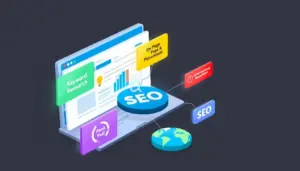
On-page SEO enhances your website’s visibility and attracts organic traffic by optimizing elements like title tags, meta descriptions, and headings. These elements help search engines understand your content and improve rankings.
Image SEO is also crucial. Optimize images with relevant keywords, descriptive anchor text, and links to related content to improve chances of ranking higher and enhance overall SEO performance.
Let’s delve deeper into each of these on-page optimization techniques.
Craft Compelling Title Tags
Title tags are essential for SEO as they help search engines understand webpage content and improve click-through rates. Each page has a title tag and an H1 tag, each playing different roles in content structure and SEO.
Title tags should be unique, concise, and descriptive, incorporating the target keyword to reflect the page’s content accurately. Keep title tags between 50-60 characters to maximize visibility and clarity.
Write Engaging Meta Descriptions
A meta description summarizes a webpage and appears below the title in search results. Make it compelling, include relevant keywords, and keep it under 155 characters to enhance click-through rates.
Like title tags, meta descriptions should be unique to each page.
Use Headings Effectively
Using heading tags (H1-H6) establishes a clear content hierarchy, improving readability and SEO. Headings guide readers and help search engines understand content structure and relevance.
Effective use of headings enhances user experience and boosts on-page optimization.
Create High-Quality, SEO-Friendly Content
High-quality, SEO-friendly content is central to a successful SEO strategy. Keyword research identifies the best keywords for relevance. Long-form content like blog posts effectively targets specific keywords, fostering long-term relationships, organic growth, and increased traffic.
Incorporating experience, expertise, authority, and trust (E-E-A-T) principles builds credibility and engages the audience. High-quality content meeting E-E-A-T standards improves search rankings and builds trust. Formatting techniques like bold, italics, and heading tags enhance SEO ranking and readability.
Let’s explore how to match content to search intent, incorporate E-E-A-T principles, and optimize images for better SEO performance.
Match Content to Search Intent
Content that satisfies users’ intent improves engagement. Directly address specific queries and requirements of the target audience. Including secondary keywords enhances relevance and visibility.
Aligning content with user queries ensures it resonates with the audience and meets their needs.
Incorporate E-E-A-T Principles
Adhering to E-E-A-T principles—Expertise, Experience, Authoritativeness, and Trustworthiness—enhances content credibility and trustworthiness. SEO aims to surface accurate, trustworthy, and relevant results.
Present yourself as an authority by fine-tuning your web writing skills and using your own resources. Experts like accountants or qualified therapists can verify content accuracy according to E-E-A-T guidelines.
Optimize Images
Optimizing images is crucial for on-page SEO. Use relevant keywords in image filenames and alt text to enhance SEO potential and user engagement.
Optimized images make the search engine results more visual, providing opportunities to rank and generate traffic through image results.
Improve Internal Linking Structure
A well-organized internal linking system helps search engines discover and index pages effectively. Internal links distribute link authority throughout the site, enhancing SEO performance.
Let’s delve into how linking related pages and using descriptive anchor text can improve your internal linking structure.
Link Related Pages
Connecting relevant web pages distributes link authority throughout the site, improving SEO and enhancing user engagement by guiding readers to more relevant information.
Linking to related content helps visitors spend more time on your site, increasing the likelihood of conversions and return visits.
Use Descriptive Anchor Text
Using precise and relevant anchor text improves the clarity and context of internal links for users and search engines. Contextually rich text helps search engines understand the linked page’s subject, enhancing SEO and user navigation.
Build Credibility Through Backlinks
Backlinks enhance your website’s credibility and are essential for improving search engine ranking. Off-page SEO, which includes strategies that occur outside of your website, plays a crucial role in this process. It focuses on actions taken on other pages or platforms to enhance search engine rankings. Building a robust backlink profile involves reaching out to other websites and engaging with your local community for high-quality backlinks.
Let’s explore effective methods for acquiring backlinks and the importance of avoiding black hat techniques.
Outreach for Backlinks
Attracting backlinks requires time and dedication. Engaging with local communities builds lasting relationships and helps gain valuable backlinks, enhancing your website’s authority and visibility.
Avoid Black Hat Techniques
Black hat SEO techniques can lead to severe penalties, including removal from search results. Common practices like buying links, keyword stuffing, and cloaking offer short-term gains but harm credibility and SEO performance.
Utilize Technical SEO Best Practices
Technical SEO optimizes your website for search engine crawls, improving visibility and user experience. Strong security measures boost user trust and SEO ranking, while optimizations like fast loading speeds and seamless experiences maintain a competitive edge.
Let’s dive into improving page speed and implementing schema markup to enhance your technical SEO.
Improve Page Speed
Using relevant keywords in image names and alt text improves SEO and user engagement. Leveraging browser caching reduces loading times by storing frequently accessed resources on the user’s device.
Minimizing code by removing unnecessary characters, white spaces, and comments streamlines website performance.
Implement Schema Markup
Structured data can lead to rich snippets in search results, improving visibility and click-through rates. Schema markup helps search engines understand your website content better.
Schema markup provides search engines with context about your pages’ content, enhancing SEO performance and attracting more visitors.
Monitor and Adjust Your SEO Strategy
Monitoring SEO performance is essential to understand effectiveness and identify areas for improvement. Regular adjustments capitalize on new ranking opportunities and stay ahead of competition. Increased traffic signals to search engines indicate valuable and relevant content, positively impacting rankings.
Let’s explore the use of Google Analytics and Google Search Console for monitoring and tracking key metrics to refine your SEO strategy.
Use Google Analytics and Google Search Console
Google Search Console and Google Analytics are essential tools for monitoring site performance and visitor interaction. Setting up a property in Google Analytics involves providing details like the website’s name, time zone, and currency. Check indexing errors in Google Search Console before implementing SEO strategies.
Integrating these tools with others like Semrush provides a more detailed view of site performance.
Track Key Metrics
Tracking key metrics like impressions, clicks, click-through rates (CTR), and conversion rates is crucial for analyzing performance. Impressions represent how often users see your site in search results, while clicks indicate user actions. Monitoring CTR helps assess the effectiveness of meta titles and descriptions.
Conversion rates reflect how well your pages achieve desired actions, providing insights into site performance.
Summary
Throughout this guide, we’ve delved into the essential steps for optimizing your website for higher search rankings and more traffic. From setting up your website, conducting thorough keyword research, and optimizing on-page elements to creating high-quality content, building internal and external links, utilizing technical SEO best practices, and incorporating off-page SEO strategies, each step plays a crucial role in your SEO strategy.
By monitoring and adjusting your SEO efforts using tools like Google Analytics and Google Search Console, you can continuously refine your strategy, capitalize on new opportunities, and stay ahead of the competition. Remember, SEO is an ongoing process that requires dedication, patience, and a willingness to adapt to ever-changing search algorithms.
Take these insights and strategies to heart, implement them diligently, and watch as your website climbs the search engine rankings, attracts more traffic, and achieves greater success.
Frequently Asked Questions
Why is keyword research important for SEO?
Keyword research is crucial for SEO as it uncovers the terms your target audience uses, allowing you to tailor your content effectively for better organic traffic and enhanced search rankings. This strategic approach directly influences your site’s visibility and relevance.
How can I ensure my website is mobile responsive?
To ensure your website is mobile responsive, test it on various mobile devices for smooth functionality and choose a theme that emphasizes mobile responsiveness. This approach will enhance the experience for your mobile visitors.
What are long-tail keywords and why should I use them?
Using long-tail keywords is essential because they target niche audiences and often have less competition, resulting in higher conversion rates for your content. By incorporating these specific phrases, you can effectively reach and engage your ideal customers.
What are some effective methods for acquiring backlinks?
Engaging with your local community and reaching out to relevant websites are effective methods to acquire high-quality backlinks, boosting your website’s authority and visibility in search engine results. Focus on building genuine connections to maximize your backlink strategy.
Why should I avoid black hat SEO techniques?
Avoiding black hat SEO techniques is crucial because they can result in severe penalties from search engines that damage your website’s credibility and overall SEO performance. Prioritizing ethical practices will ensure long-term success and visibility in search results.

